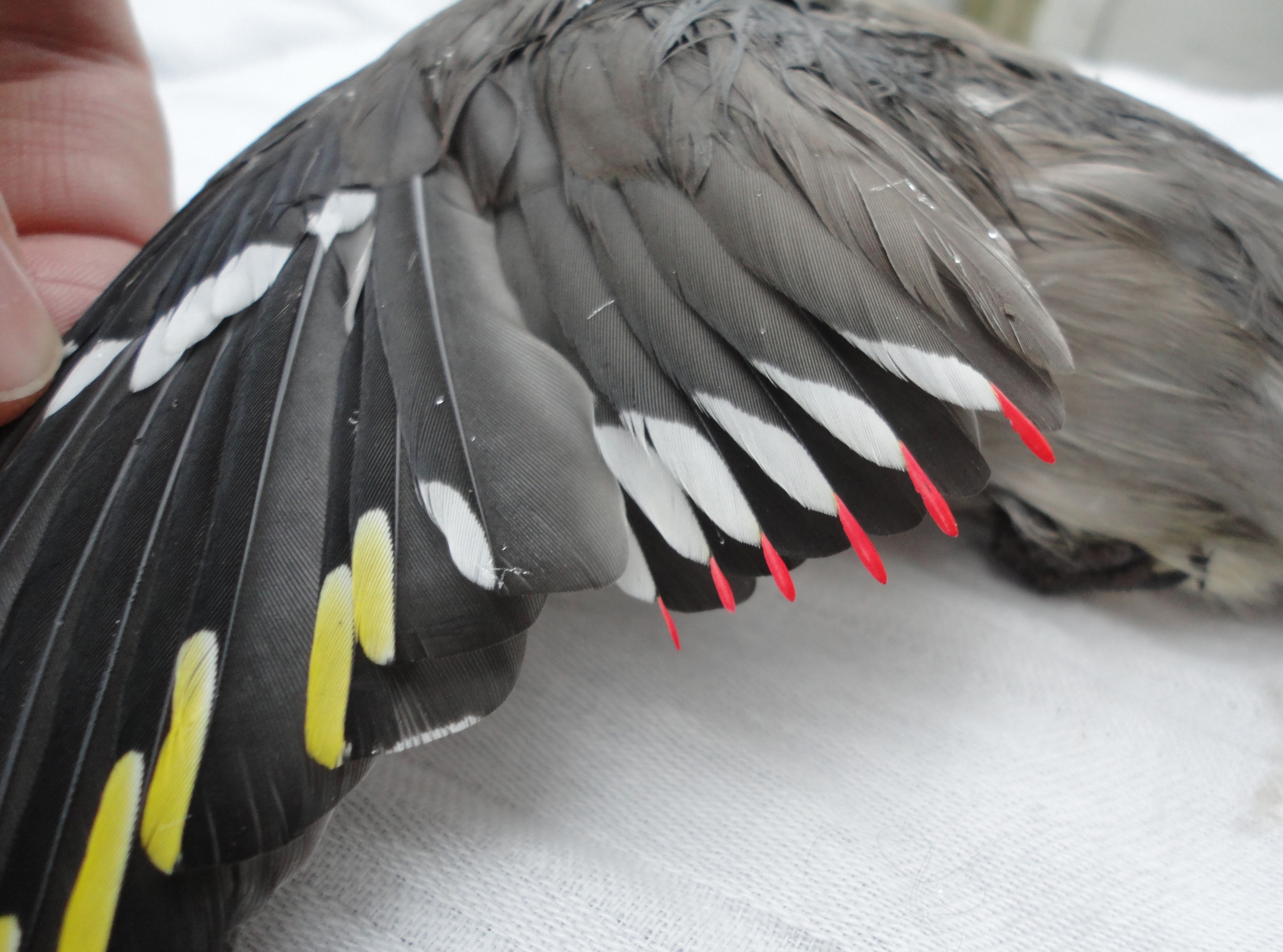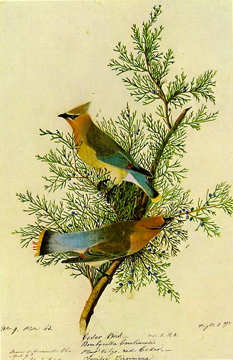|
Waxwing
The waxwings are three species of passerine birds classified in the genus ''Bombycilla''. They are pinkish-brown and pale grey with distinctive smooth plumage in which many body feathers are not individually visible, a black and white eyestripe, a crest, a square-cut tail and pointed wings. Some of the wing feathers have red tips, the resemblance of which to sealing wax gives these birds their common name. According to most authorities, this is the only genus placed in the family Bombycillidae, although sometimes the family is extended to include related taxa that are more usually included in separate families: silky flycatchers ( Ptiliogonatidae (e.g. '' Phainoptila'')), ''Hypocolius'' ( Hypocoliidae), ''Hylocitrea'' ( Hylocitreidae), palmchats ( Dulidae) and the Hawaiian honeyeaters ( Mohoidae). There are three species: the Bohemian waxwing (''B. garrulus''), the Japanese waxwing (''B. japonica'') and the cedar waxwing (''B. cedrorum''). Waxwings are not long-distance migra ... [...More Info...] [...Related Items...] OR: [Wikipedia] [Google] [Baidu] |
Bohemian Waxwing
The Bohemian waxwing (''Bombycilla garrulus'') is a starling-sized passerine bird that breeds in the northern forests of the Palearctic and North America. It has mainly buff-grey plumage, black face markings and a pointed crest. Its wings are patterned with white and bright yellow, and some of the wing feathers have red tips, the resemblance of which to sealing wax gives these birds their common name. The two or three subspecies show only minor differences in appearance. Females are similar to males, although young birds are less well-marked and have few or no waxy wingtips. Although the Bohemian waxwing's range overlaps those of the cedar and Japanese waxwings, it is easily distinguished from them by size and plumage differences. The breeding habitat is coniferous forests, usually near water. The pair build a lined cup-shaped nest in a tree or bush, often close to the trunk. The clutch of 3–7 eggs is incubated by the female alone for 13–14 days to hatching. The chic ... [...More Info...] [...Related Items...] OR: [Wikipedia] [Google] [Baidu] |
Bombycilla Cedrorum
The cedar waxwing (''Bombycilla cedrorum'') is a member of the family Bombycillidae or waxwing family of passerine birds. It is a medium-sized bird that is mainly brown, gray, and yellow. Some of the wing feathers have red tips, the resemblance of which to sealing wax gives these birds their common name. It is a native of North and Central America, breeding in open wooded areas in southern Canada and wintering in the southern half of the United States, Central America, and the far northwest of South America. Its diet includes cedar cones, fruit, holly berries, and insects. The cedar waxwing is listed as least concern on the IUCN Red List. The genus name ''Bombycilla'' comes from the Ancient Greek ''bombux'', "silk" and the Modern Latin ''cilla'', "tail"; this is a direct translation of the German ''Seidenschwanz'', "silk-tail", and refers to the silky-soft plumage of these birds. The specific ''cedrorum'' is Latin for "of the cedars". Description Cedar waxwings are medium-sized ... [...More Info...] [...Related Items...] OR: [Wikipedia] [Google] [Baidu] |
Cedar Waxwing
The cedar waxwing (''Bombycilla cedrorum'') is a member of the waxwing, family Bombycillidae or waxwing family of passerine birds. It is a medium-sized bird that is mainly brown, gray, and yellow. Some of the wing feathers have red tips, the resemblance of which to sealing wax gives these birds their common name. It is a native of North and Central America, breeding in open wooded areas in southern Canada and wintering in the southern half of the United States, Central America, and the far northwest of South America. Its diet includes cedar cones, fruit, holly berries, and insects. The cedar waxwing is listed as Least-concern species, least concern on the IUCN Red List. The genus name ''Bombycilla'' comes from the Ancient Greek ''bombux'', "silk" and the Neo-Latin, Modern Latin ''cilla'', "tail"; this is a direct translation of the German ''Seidenschwanz'', "silk-tail", and refers to the silky-soft feather, plumage of these birds. The specific ''cedrorum'' is Latin for "of the ced ... [...More Info...] [...Related Items...] OR: [Wikipedia] [Google] [Baidu] |
Bombycilla Japonica
The Japanese waxwing (''Bombycilla japonica'') is a fairly small passerine bird in the waxwing family found in the eastern Palaearctic, where it breeds south of the breeding range of the related Bohemian waxwing, but overlaps extensively with it in winter. It feeds mainly on fruit and berries but also eats insects during the summer. The nest is a cup of twigs lined with grass and moss which is built in a tree. In males, the secondary wing feathers have red tips, the resemblance of which to sealing wax gives these birds their common name. It is listed by IUCN as Near Threatened, due to loss and degradation of its preferred forest habitat. Description The Japanese waxwing is 15–18 cm in length with a weight of 54–64 g, and its plumage is mostly pinkish-brown. It has a pointed crest, a black throat, a black stripe through the eye, a pale yellow centre to the belly, a grey rump, rusty-red undertail coverts, and a dark grey tail with a black-bordered red tip. The wings have a ... [...More Info...] [...Related Items...] OR: [Wikipedia] [Google] [Baidu] |
Japanese Waxwing
The Japanese waxwing (''Bombycilla japonica'') is a fairly small passerine bird in the waxwing family found in the eastern Palaearctic, where it breeds south of the breeding range of the related Bohemian waxwing, but overlaps extensively with it in winter. It feeds mainly on fruit and berries but also eats insects during the summer. The nest is a cup of twigs lined with grass and moss which is built in a tree. In males, the secondary wing feathers have red tips, the resemblance of which to sealing wax gives these birds their common name. It is listed by IUCN as Near Threatened, due to loss and degradation of its preferred forest habitat. Description The Japanese waxwing is 15–18 cm in length with a weight of 54–64 g, and its plumage is mostly pinkish-brown. It has a pointed crest, a black throat, a black stripe through the eye, a pale yellow centre to the belly, a grey rump, rusty-red undertail coverts, and a dark grey tail with a black-bordered red tip. The wings have a ... [...More Info...] [...Related Items...] OR: [Wikipedia] [Google] [Baidu] |
Hypocoliidae
The grey hypocolius or simply hypocolius (''Hypocolius ampelinus'') is a small passerine bird species. It is the sole member of the genus ''Hypocolius'' and it is placed in a family of its own, the Hypocoliidae. This slender and long tailed bird is found in the dry semi-desert region of northern Africa, Arabia, Afghanistan, Pakistan, and western India. They fly in flocks and forage mainly on fruits, migrating south in winter. During migration they are often found feeding on the fruits of ''Salvadora persica''. Description The grey hypocolius is a slim bird with a long tail, slight crest and thick, short hook-tipped bill. Its shape and soft, satiny plumage resembles that of the waxwing. Birds are mainly a uniform grey or brownish-grey colour, with males having a black triangular mask around the eyes. They have white-tipped black primary wing feathers and a black terminal band on the tail. Adults are about in length. The head feathers are raised when the bird is excited. They fly ... [...More Info...] [...Related Items...] OR: [Wikipedia] [Google] [Baidu] |
Bombycilloidea
Bombycilloidea is a Superfamily (biology), superfamily of Passerine, passerine birds that contains ten living species. They are found in North America, North, Central America, most of the Palearctic realm, Palearctic, the Arabian Peninsula, the islands of Hispaniola and Sulawesi, and formerly the Hawaiian Islands. Taxonomy The superfamily includes only ten extant species. It is Sister group, sister to a clade containing Muscicapoidea, Certhioidea, Certhoidea and Kinglet, Regulidae (both clades are contained within the Order (biology), parvorder Muscicapida), from which it diverged during the mid-late Oligocene, about 25 million years ago. The common ancestor for both clades lived in Eurasia; at some point, the ancestral Bombycilloidea arrived in North America where they rapidly radiated into multiple families. One of these lineages moved back into Eurasia, where it gave rise to several lineages that stayed in Eurasia or colonized Wallacea or Hawaii. Two families, the waxwings ( ... [...More Info...] [...Related Items...] OR: [Wikipedia] [Google] [Baidu] |
Palm Chat
The palmchat (''Dulus dominicus'') is a small, long-tailed passerine bird, the only species in the genus ''Dulus'' and the family Dulidae endemic to the Caribbean island of Hispaniola (split between the Dominican Republic and Haiti). It is related to the waxwings, family Bombycillidae. Its name reflects its strong association with palms for feeding, roosting, and nesting. The palmchat is the national bird of the Dominican Republic. Taxonomy In 1760 the French zoologist Mathurin Jacques Brisson included a description of the palmchat in his ''Ornithologie'' based on a specimen collected from the French colony of Saint-Domingue, modern Haiti. He used the French name ''Le tangara de S. Dominigue'' and the Latin ''Tangara Dominicensis''. The two stars (**) at the start of the section indicates that Brisson based his description on the examination of a specimen. Although Brisson coined Latin names, these do not conform to the binomial system and are not recognised by the Internatio ... [...More Info...] [...Related Items...] OR: [Wikipedia] [Google] [Baidu] |
Grey Hypocolius
The grey hypocolius or simply hypocolius (''Hypocolius ampelinus'') is a small passerine bird species. It is the sole member of the genus ''Hypocolius'' and it is placed in a family of its own, the Hypocoliidae. This slender and long tailed bird is found in the dry semi-desert region of northern Africa, Arabia, Afghanistan, Pakistan, and western India. They fly in flocks and forage mainly on fruits, migrating south in winter. During migration they are often found feeding on the fruits of ''Salvadora persica''. Description The grey hypocolius is a slim bird with a long tail, slight crest and thick, short hook-tipped bill. Its shape and soft, satiny plumage resembles that of the waxwing. Birds are mainly a uniform grey or brownish-grey colour, with males having a black triangular mask around the eyes. They have white-tipped black primary wing feathers and a black terminal band on the tail. Adults are about in length. The head feathers are raised when the bird is excited. They fly ... [...More Info...] [...Related Items...] OR: [Wikipedia] [Google] [Baidu] |



